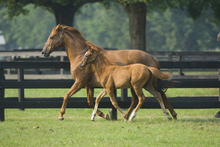In horse breeding, stallions are usually used to establish a breeding line. In some cases, however, the maternal lineage plays a more important role.

Importance of mare lineage in foal development
At the Graf Lehndorff Institute for Equine Science, Juliane Kuhl and Christine Aurich investigated the degree to which the maternal lineage influences gestation length and foal characteristics in horses and came to some interesting conclusions.
Researchers have looked at the gestation length of different mare families and discovered that the length of gestation varies significantly from lineage to lineage. Certain families also produce more female offspring than male foals.
Owners of sport and leisure horses are keen on knowing the parentage of their animals. A horse with a good pedigree will often have the desired characteristics in terms of speed, physique and health.
At the Graf Lehndorff Institute for Equine Science, a joint research institution of the Vetmeduni Vienna and the Brandenburg State Stud in Germany, Juliane Kuhl and Christine Aurich investigated the degree to which the maternal lineage influences gestation length and foal characteristics.
Together with statistician Kathrin Stock of the agricultural statistics centre VIT in Germany, they analysed the data records for 640 pregnancies in 142 mares.
Maternal lineage influences gestation length
The broodmares could be assigned to different mare families or lineages. The analysis revealed that the average length of gestation, which in horses ranges between 320 and 360 days, varies from family to family.
The gestation length of some maternal lineages was on average 10 days longer than in other families. The fact that gestation length for male foals tends to be generally longer than for female foals is added to the variation from family to family.
"We can still not predict the exact time of birth. The individual fluctuations among individual pregnancies are simply too large. But the information gained from the study can help us to narrow the possible range," says first author Juliane Kuhl.
"The length of gestation is also of interest for horse breeders. Ideally, a broodmare should give birth to a foal every year. Due to the average gestation which covers approximately 11 months, longer gestation lengths result in a delay in birth of the next foal.
Breeders are interested in having foals born at the beginning of the year, as the horses will then compete better against animals born in the same year," Kuhl explains.
Mare pedigree influences foal sex ratio
The study also showed that certain maternal lineages produce more female than male foals. The age of the mare also plays a role. Young mares who have their first pregnancy when they are three years old will produce more female foals.
Older mares also tend to have more female offspring. For middle-aged mares between four and twelve years the foal sex ratio is balanced.
"These results are important for horse breeders. They could possibly choose their mares depending on the desired sex of a foal," Kuhl believes.
The mechanism behind this phenomenon remains unclear, however.
"We suspect that these effects are due to the differences in mitochondrial DNA. This specific DNA is inherited over the maternal line and influences cell metabolism and placenta function," says study director Christine Aurich.
"We also know that female embryos are more resilient. As 20 to 30 percent of early pregnancies are lost spontaneously, it is possible that male embryos survive less frequently. This could be a reason for the observed shift in the sex ratio. But it is also possible that embryo survival is influenced by differences in placental function," Aurich says.
Journal Reference:
- J. Kuhl, K. F. Stock, M. Wulf, C. Aurich. Maternal Lineage of Warmblood Mares Contributes to Variation of Gestation Length and Bias of Foal Sex Ratio. PLOS ONE, 2015; 10 (10): e0139358 DOI: 10.1371/journal.pone.0139358
